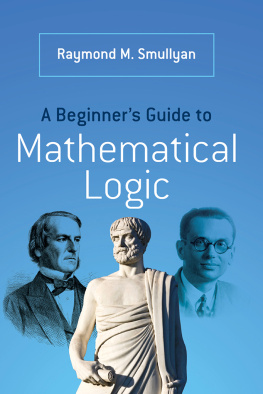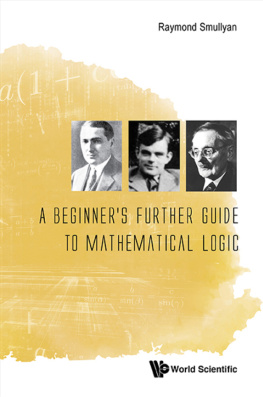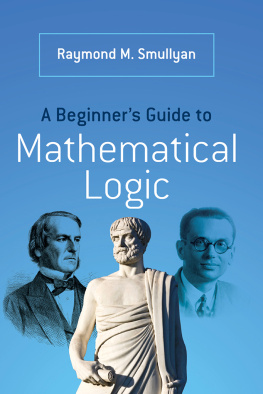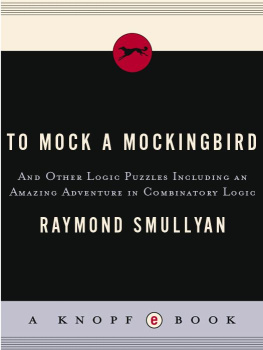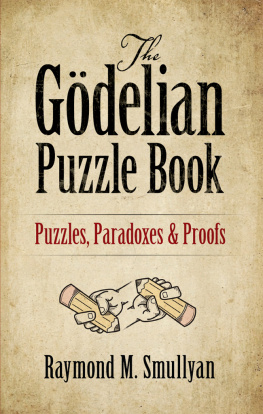Raymond M. Smullyan - The Gödelian Puzzle Book: Puzzles, Paradoxes and Proofs
Here you can read online Raymond M. Smullyan - The Gödelian Puzzle Book: Puzzles, Paradoxes and Proofs full text of the book (entire story) in english for free. Download pdf and epub, get meaning, cover and reviews about this ebook. year: 2013, publisher: Dover Publications, genre: Religion. Description of the work, (preface) as well as reviews are available. Best literature library LitArk.com created for fans of good reading and offers a wide selection of genres:
Romance novel
Science fiction
Adventure
Detective
Science
History
Home and family
Prose
Art
Politics
Computer
Non-fiction
Religion
Business
Children
Humor
Choose a favorite category and find really read worthwhile books. Enjoy immersion in the world of imagination, feel the emotions of the characters or learn something new for yourself, make an fascinating discovery.

- Book:The Gödelian Puzzle Book: Puzzles, Paradoxes and Proofs
- Author:
- Publisher:Dover Publications
- Genre:
- Year:2013
- Rating:4 / 5
- Favourites:Add to favourites
- Your mark:
- 80
- 1
- 2
- 3
- 4
- 5
The Gödelian Puzzle Book: Puzzles, Paradoxes and Proofs: summary, description and annotation
We offer to read an annotation, description, summary or preface (depends on what the author of the book "The Gödelian Puzzle Book: Puzzles, Paradoxes and Proofs" wrote himself). If you haven't found the necessary information about the book — write in the comments, we will try to find it.
Raymond M. Smullyan: author's other books
Who wrote The Gödelian Puzzle Book: Puzzles, Paradoxes and Proofs? Find out the surname, the name of the author of the book and a list of all author's works by series.
The Gödelian Puzzle Book: Puzzles, Paradoxes and Proofs — read online for free the complete book (whole text) full work
Below is the text of the book, divided by pages. System saving the place of the last page read, allows you to conveniently read the book "The Gödelian Puzzle Book: Puzzles, Paradoxes and Proofs" online for free, without having to search again every time where you left off. Put a bookmark, and you can go to the page where you finished reading at any time.
Font size:
Interval:
Bookmark:
THE GDRIN
PUZZLE BOOK
THE GDELIM
PUZZLE BOOK
Puzzles, Paradoxes and Proofs
Raymond M. Smullyan
DOVER PUBLICATIONS, INC.
Mineola, New York
Copyright
Copyright 2013 by Raymond M. Smullyan
All rights reserved.
Bibliographical Note
The Gdelian Puzzle Book is a new work, first published by Dover Publications, Inc., in 2013.
International Standard Book Number
eISBN-13: 978-0-486-31577-5
Manufactured in the United States by Courier Corporation
49705401 2013
www.doverpublications.com
PREFACE
This book, like hardly any others, explains the pioneering discoveries of the amazing logician Kurt Gdel through recreational logic puzzles. Its title is based on the fact that almost all the puzzles of the book are centered around Gdels celebrated result.
In the first quarter of the twentieth century there were some mathematical systems in existence that were so comprehensive that it was generally assumed that every mathematical statement could either be proved or disproved within the system. In 1931 Gdel astounded the entire mathematical world by showing that this was not the case [Gdel, 1931]: For each of the mathematical systems in question, there must always be mathematical statements that can be neither proved nor disproved within the system. Indeed, Gdel provided an actual recipe for exhibiting in each such system, a sentence which must be true, but not provable, in the system. This famous result is known as Gdels Theorem.
The essential idea behind Gdels proof is this:
Gdel assigned to each mathematical sentence of the system a number, now known as the Gdel number of the sentence. He then constructed a most ingenious sentence S that asserted that a certain number n was the Gdel number of a sentence that was not provable in the system. Thus this sentence S was true if and only if n was the Gdel number of an unprovable sentence. But the amazing thing is that n was the Gdel number of the very sentence S! Thus S asserted that its own Gdel number was the Gdel number of an unprovable sentence. Thus in effect, S was a self-referential sentence that asserted its own non-provability. This meant that either S was true and not provable or S was false but provable. The latter alternative seemed completely out of the question since it was obvious from the nature of the system in question that only true sentences could be proved in the system. Thus Gdels sentence S was true but not provable in the system. Its truth was known only by going outside the system and noting some of its properties.
How did Gdel manage to construct such an ingenious sentence? It is the purpose of this book to explain how, in terms that are completely comprehensible to the general publiceven those with no background at all in mathematical logic. I have written this book so that it should be perfectly comprehensible to any reasonably bright high-school student. This is actually the first of my popular logic puzzle books in which I give a complete proof of Gdels theorem for one particularly important mathematical system, as well as provide a host of generalizations that have never been published before, and should therefore be of interest, not only to the general reader, but to the logical specialist as well. These generalizations can be found in
On the whole, I have written this book in a very informal style. After the chatty introductory first three of its chapters contain my generalized Gdel theorems, which are unusual in that they do not involve the usual machinery of symbolic logic! I have deferred symbolic logicthe logical connectives and quantifiersto the last three chapters, which begin by explaining its basics and what is known as first-order arithmetic followed by a presentation of the famous axiom system known as Peano Arithmetic. And I give a complete proof there of Gdels celebrated result that there are sentences of Peano Arithmetic that cannot be proved or disproved with in that axiom system.
Gdels discoveries have led to an even more important result: Is there any purely mechanical method of determining which mathematical statements are true and which are false? This brings us to the subject of decision. theory, better known as recursion theory, which today plays such a vital role in computer science. of this book explains some basics of this important field. It turns out that in fact there is no purely mechanical method of deciding which mathematical statements are true and which are not! No computer can possibly settle all mathematical questions. It seems that brains and ingenuity are, and always will be, required. In the witty words of the mathematician Paul Rosenbloom, this means that Man can never eliminate the necessity of using his own intelligence, regardless of how cleverly he tries!
I would like to thank Dr. Sue Toledo for her very helpful editing work on this book.
TABLE OF CONTENTS
PART I
PUZZLES, PARADOXES, INFINITY AND OTHER CURIOSITIES
CHAPTER I
A CHATTY PERSONAL INTRODUCTION
Let me introduce myself by what might be termed a meta-introduction, by which I mean that I will tell you of three amusing introductions I have had in the past.
1. The first was by the logician Professor Melvin Fitting, formerly my student, whom I will say more about later on. I must first tell you of the background of this introduction. In my puzzle book What is the Name of this Book? I gave a proof that either Tweedledee or Tweedledum exists, but there is no way to tell which. Elsewhere I constructed a mathematical system in which there are two sentences such that one of them must be true but not provable in the system, but there is no way to know which one it is. [Later in this book, I will show you this system.] All this led Melvin to once introduce me at a math lecture by saying, I now introduce Professor Smullyan, who will prove to you that either he doesnt exist, or you dont exist, but you wont know which!
2. On another occasion, the person introducing me said at one point, Professor Smullyan is unique. I was in a mischievous mood at the time, and I could not help interrupting him and saying, Im sorry to interrupt you Sir, but I happen to be the only one in the entire universe who is not unique!
3. This last introduction (perhaps my favorite) was by the philosopher and logician Nuel Belnap Jr., and could be applicable to anybody. He said, I promised myself three things in this introduction: First, to be brief, second, not to be facetious, and third, not to refer to this introduction.
I particularly liked the last introduction because it involved self-reference, which is a major theme of this book.
I told you that I would tell you more about Melvin Fitting. He really has a great sense of humor. Once when he was visiting at my house, someone complained of the cold. Melvin then said, Oh yes, as it says in the Bible, many are cold but few are frozen. Next morning I was driving Melvin through town, and at one point he asked me, Why are all these signs advertising slow children?
On another occasion, we were discussing the philosophy of solipsism (which is the belief I am the only one who exists!). Melvin said, Of course I know that solipsism is the correct philosophy, but thats only one mans opinion. This reminds me of a letter a lady wrote to Bertrand Russel, in which she said, Why are you surprised that I am a solipsist? Isnt everybody?
I once attended a long and boring lecture on solipsism. At one point I rose and said, At this point, Ive become an anti-solipsist. I believe that everybody exists except me.
Do you have any rational evidence that you are now awake? Isnt it logically possible that you are now asleep and dreaming all this? Well, I once got into an argument with a philosopher about this. He tried to convince me that I had no rational evidence to justify believing that I was now awake. I insisted that I was perfectly justified in being certain that I was awake. We argued long and tenaciously, and I finally won the argument, and he conceded that I did have rational evidence that I was awake. At that point I woke up.
Next pageFont size:
Interval:
Bookmark:
Similar books «The Gödelian Puzzle Book: Puzzles, Paradoxes and Proofs»
Look at similar books to The Gödelian Puzzle Book: Puzzles, Paradoxes and Proofs. We have selected literature similar in name and meaning in the hope of providing readers with more options to find new, interesting, not yet read works.
Discussion, reviews of the book The Gödelian Puzzle Book: Puzzles, Paradoxes and Proofs and just readers' own opinions. Leave your comments, write what you think about the work, its meaning or the main characters. Specify what exactly you liked and what you didn't like, and why you think so.

